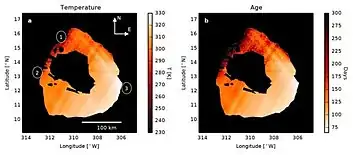
Loki Patera /ˈloʊki ˈpætərə/ is the largest volcanic depression on Jupiter's moon Io, 202 kilometres (126 mi) in diameter.[1] It contains an active lava lake, with an episodically overturning crust.[2] The level of activity seen is similar to a superfast spreading mid-ocean ridge on Earth.[3] Temperature measurements of thermal emission at Loki Patera taken by Voyager 1's Infrared Interferometer Spectrometer and Radiometer (IRIS) instrument were consistent with sulfur volcanism.[4]
Io's lava lakes such as Loki Patera are depressions partially filled with molten lava covered by a thin solidified crust. These lava lakes are directly connected to a magma reservoir below.[5] Observations of thermal emission at several of Io's lava lakes reveal glowing molten rock along Loki Patera's margin, caused by the lake's crust breaking up along the edge of the patera. Over time, because the solidified lava is denser than the still-molten magma below, this crust can founder, exposing fresh, hot molten rock.[6] At sites such as Loki Patera, this can occur episodically. During an overturning episode, Loki can emit up to ten times more heat than when its crust is stable.[2] During an eruption, a wave of foundering crust spreads out across the patera at the rate of about 1 kilometre (0.6 mi) per day, until the crust of the lake has been resurfaced. Another eruption would begin once the new crust has cooled and thickened enough for it to no longer be buoyant over the molten lava.[7]

On March 8, 2015 a rare orbital alignment occurred between Io and Europa, two of the moons of Jupiter, that allowed researchers to distinguish heat being emitted from Loki Patera. They were able to accomplish this because Europa's surface is coated in water ice which reflects small amounts of sunlight at infrared wavelengths. Scientists were able to determine that there were two waves of resurfacing lava, which explains the change in brightness on Loki Patera every 400–600 days. The images that helped researchers discover this were captured by the Large Binocular Telescope Observatory in southeast Arizona. The observation also revealed that there is a difference in the magma supply of the two halves of Loki.[8]
Loki Patera is located at 13°00′N 308°48′W / 13°N 308.8°W[9]. It is named after the Norse god Loki.[9] Amaterasu Patera is located to the north and Manua Patera to the northwest.
See also
References
- ↑ Radebaugh, J.; et al. (2001). "Paterae on Io: A new type of volcanic caldera?". J. Geophys. Res. 106 (E12): 33005–33020. Bibcode:2001JGR...10633005R. doi:10.1029/2000JE001406.
- 1 2 Howell, R. R.; R. M. C. Lopes (2007). "The nature of the volcanic activity at Loki: Insights from Galileo NIMS and PPR data". Icarus. 186 (2): 448–461. Bibcode:2007Icar..186..448H. doi:10.1016/j.icarus.2006.09.022.
- ↑ Rosaly M.C. Lopes and Tracy K.P. Gregg (2004). Lava Lakes on Jupiter’s Moon Io (abstract) Archived 2007-10-09 at the Wayback Machine
- ↑ Hanel, R.; et al. (1979). "Infrared Observations of the Jovian System from Voyager 1". Science. 204 (4396): 972–76. doi:10.1126/science.204.4396.972-a. PMID 17800431. S2CID 43050333.
- ↑ Davies, A. (2007). "Effusive activity: landforms and thermal emission evolution". Volcanism on Io: A Comparison with Earth. Cambridge University Press. pp. 142–52. ISBN 978-0-521-85003-2.
- ↑ Matson, D. L.; et al. (2006). "Io: Loki Patera as a magma sea". J. Geophys. Res. 111 (E9): E09002. Bibcode:2006JGRE..111.9002M. doi:10.1029/2006JE002703.
- ↑ Rathbun, J. A.; J. R. Spencer (2006). "Loki, Io: New ground-based observations and a model describing the change from periodic overturn". Geophysical Research Letters. 33 (17): L17201. arXiv:astro-ph/0605240. Bibcode:2006GeoRL..3317201R. doi:10.1029/2006GL026844. S2CID 29626659.
- ↑ University of California, Berkeley (10 May 2017). "Waves of lava seen in Jupiter's moon Io's largest volcanic crater". Retrieved 11 October 2017.
- 1 2 "Loki Patera". Gazetteer of Planetary Nomenclature. USGS Astrogeology Research Program.
